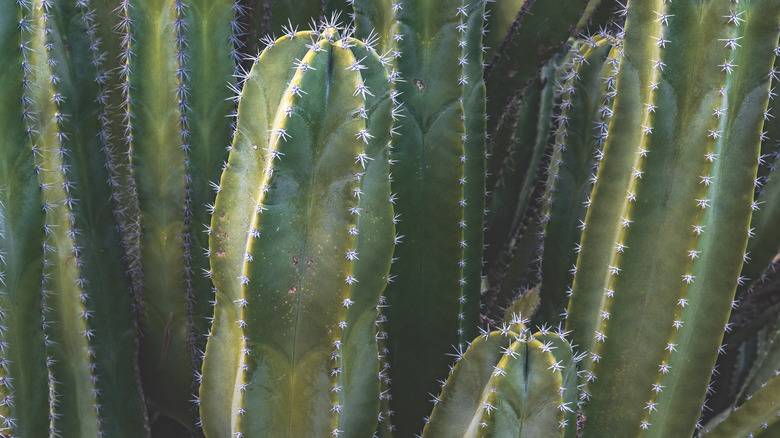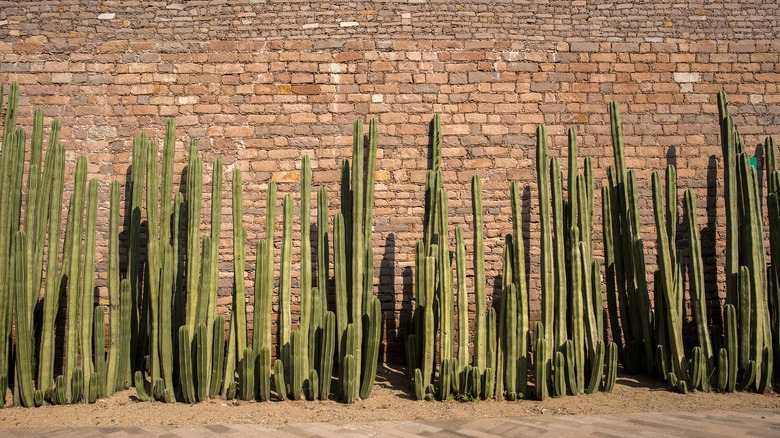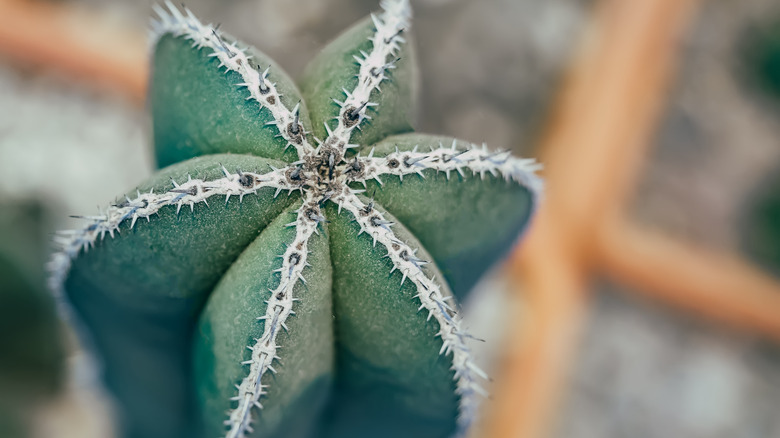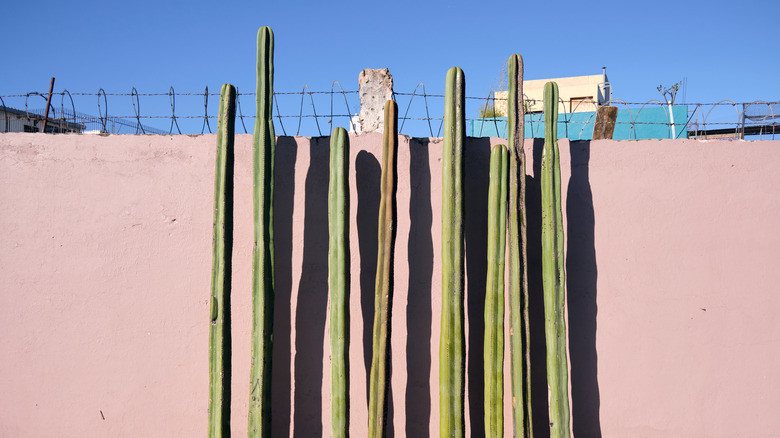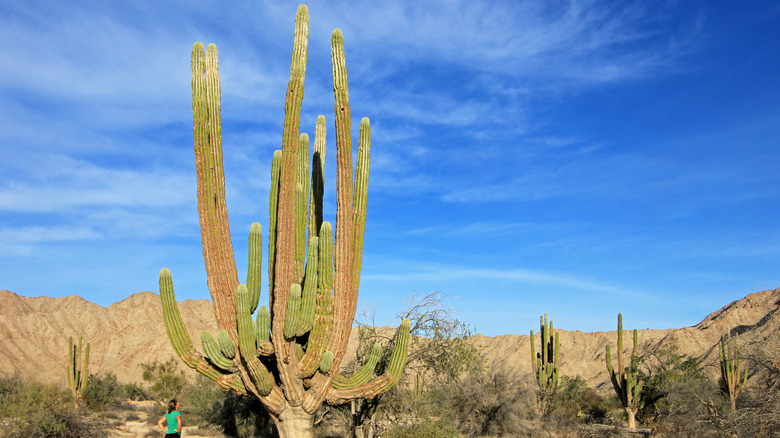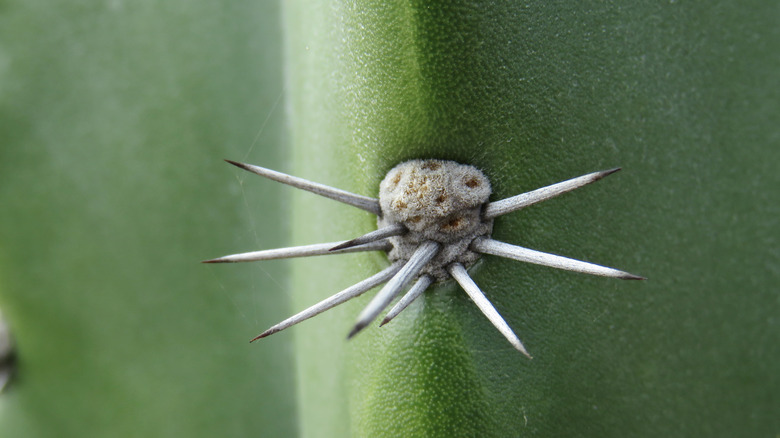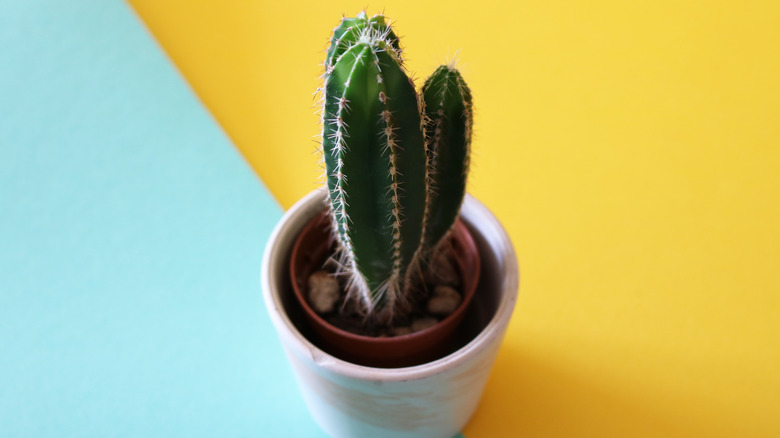How To Care For A Mexican Fence Post Cactus
Pachycereus marginatus is a species of cacti that are native to Central America including Oaxaca, San Luis Potosí, and Querétaro, as per Llifle. Known as the Mexican fence post cactus, it is often used as a barrier in hotter climates that support its growth. These stiff plants can grow up to 50 feet tall in the wild, but stay closer to 12 feet when cultivated domestically. Often they split at their base to form two or more branches, all of which grow upright.
Each branch of the Mexican fence post cactus is dark green with 5 to 7 ribs that form its cylindrical body. Down the center of each rib is a line of areolas that feature many white spikes. According to The University of Arizona, as the cacti age, their spines become shorter and pink or green bell-shaped flowers will begin blooming. Later in the season, blossoms give way to spiny red fruits that can be used to make jam. The Mexican fence post cactus is easy to care for and relatively cold hardy, surviving in temperatures as low as 20 degrees Fahrenheit for short periods of time. It will be happiest and healthiest, however, if you can provide it with adequate heat and sunlight.
How to use a Mexican fence post cactus in the garden
In hotter areas such as Mexico, Arizona, Texas, New Mexico, and Southern California, growing Mexican fence post cacti outdoors is common. As mentioned, they are most often grown in rows to create a tall barrier or fence. As your cacti multiply, your fence will become thicker, thus increasing your privacy. They can also be used as focal points or as a backdrop wall in your garden. You can define areas of your garden by separating them with a few tall cacti. No matter how you plant yours, they'll easily make a statement.
Though Mexican fence post cacti love high temperatures and direct sunlight, they are susceptible to sun damage from overexposure when they are young. Placing furniture or potted plants near them can help save your cacti from developing dark scars and yellow skin, says Opportunity Muse. You can easily move the furniture and pots away when your cacti are old enough to withstand the harsh sunlight. Alternatively, you could keep your Mexican fence post cactus in a pot until it is mature enough to transplant into a sun-filled spot in the ground.
How to grow Mexican fence post cacti
Mexican fence post cacti can be grown from cuttings or seeds. However, you will need to gather some supplies before you get started. These include a sharp, sterile blade, gloves, well-draining cactus potting soil, and a small pot. To begin propagating from cuttings, locate a stem that has branched off the mother plant. As explained by Plantophiles, you will not need to remove the original plant from its container. Simply use your knife to slice off the stem at the point where it branches off. Then, place the cutting in a warm place so it can dry. After a few weeks have passed, the cut should be calloused over. At this point, you can plant the stem into a pot filled with moist, cactus-specific soil with the calloused side down. When the cactus is secured upright, you can place the pot in a warm area where it will take root.
Growing a Mexican fence post cactus from seeds is much more difficult. You can buy the seeds online or possibly at your local nursery. Alternatively, you may also derive your seeds from your own mature cactus that is bearing fruit. As per Sublime Succulents, you must dry your seeds thoroughly before planting. After placing the seeds into some moist cactus potting soil, you'll need to wait weeks before small green sprouts appear. Healthy young plants should be transplanted into larger containers to encourage growth.
How to care for Mexican fence post cacti
Caring for Mexican fence post cacti is simple both indoors and out. As long as you can find them a warm sunny spot to thrive in, you won't need to take much time out of your day to perform regular care. Soil Seed and Garden suggests providing your cacti with at least six hours of direct sunlight each day. This means you should either plant it in the sunniest part of your garden or place it in your brightest window. The second aspect you should consider when caring for this plant is temperature. Mexican fence post cacti prefer temperatures of 70 to 85 degrees Fahrenheit, and they can live in much hotter climates. If you live outside of USDA hardiness zones 9 through 11, as warned by World of Succulents, your cactus will not survive outdoors. In this case, your best option is to keep it in a container that you can move from outside to inside as the weather changes.
Mexican fence post cacti are extremely drought tolerant, so watering them takes very little effort. Under-watering is more beneficial to the plant than overwatering, so make sure you aren't giving yours too much attention. Plan to water your cactus only once every two to four weeks during its growing season. Water it deeply, soaking the roots with plenty of water. Doing this in the early morning can help you make sure that the cactus won't sit in water overnight.
Pachycereus cactus varieties
The Pachycereus marginatus has only a single variety called Pachycereus marginatus f. cristata, according to Llifle. However, several similar species of Pachycereus that are sometimes confused with the Mexican fence post cactus. All cacti in the Pachycereus genus are native to Mexico and surrounding areas such as California and Arizona. They enjoy warm temperatures and sun, and they are incredibly drought tolerant. Succulent Alley describes several of these tall desert plants. Let's check them out.
-
Pachycereus marginatus f. cristata is also called the crested Mexican organ pipe cactus. It is rare and expensive, as its gorgeous rippled texture is sought after by cacti collectors and hobbyists.
-
Pachycereus militaris is a 15 to 20 foot tall cactus that features fluffy-looking brown and yellow cephalium bristles on its head. Mature Pachycereus militaris will produce flowers from this unusual terminal cap.
-
Pachycereus pringlei is more often called the Mexican giant cactus. With a trunk weight of several tons, these cacti are thought to be the biggest in the world. They have been known to survive for up to 200 years.
-
Pachycereus pecten-aboriginum is a tree-like cactus that goes by the name Indian's comb. Along with Pachycereus pringlei, it is one of the largest species of cacti.
-
Pachycereus schottii is also known as the whisker cactus. It is slow-growing like its cousins and features many tall basally branching stems.
Are Mexican fence post cacti toxic?
Mexican fence post cacti are not known to be toxic according to Tula. However, due to their sharp spines, it is wise to keep them away from pets and children who may accidentally harm themselves when grabbing or chewing on this large plant. Though the cactus is typically used only for its ornamental value, a gardener who is familiar with handling Pachycereus marginatus can harvest its red fruit. Fruit appears during the end of spring or the beginning of summer, says Llifle. They are spiny, but their soft insides can be used to make delicious jam or jelly.
Findings explained in the Journal of Medicinal Plants Research say that the plant can be used to treat gastrointestinal issues as well as diabetes. There is also some promise that extracts from the Mexican fence post cactus may have anti-tumor properties, which may help in the fights against lymphoma and melanoma. However, more research needs to be done on this species and the other 1,500 species in the Cactaceae family.
How to repot a Mexican fence post cactus
Repotting a Mexican fence post cactus is not something that you do often. Typically, you'll only need to repot yours every two or three years, according to Sublime Succulents. You can monitor your cacti by watching for roots to appear from the drainage hole or above the soil. If this happens, you know it's time to repot. Before taking the next steps to repot your cactus, make sure you protect yourself from its sharp spines. A thick pair of gloves will do. You'll also need to find a pot that is one size larger than your plant's current one and a cactus potting mix to fill it with.
To begin the repotting process, fill your new container halfway with your cactus mix. Then, remove your cactus from its old pot by holding its base secure and gently pulling the container away. Flipping it upside down or using a flat tool to dislodge the old soil may help. Once your cactus is out, knock away much of the dirt attached to its roots. Next, place the plant into the new pot and backfill with fresh soil. Press the dirt firmly around the cactus base to secure it. Let it sit in its new pot for a few hours without watering it to combat transplant shock. Water lightly afterward, and wait until the next day to water it some more.
